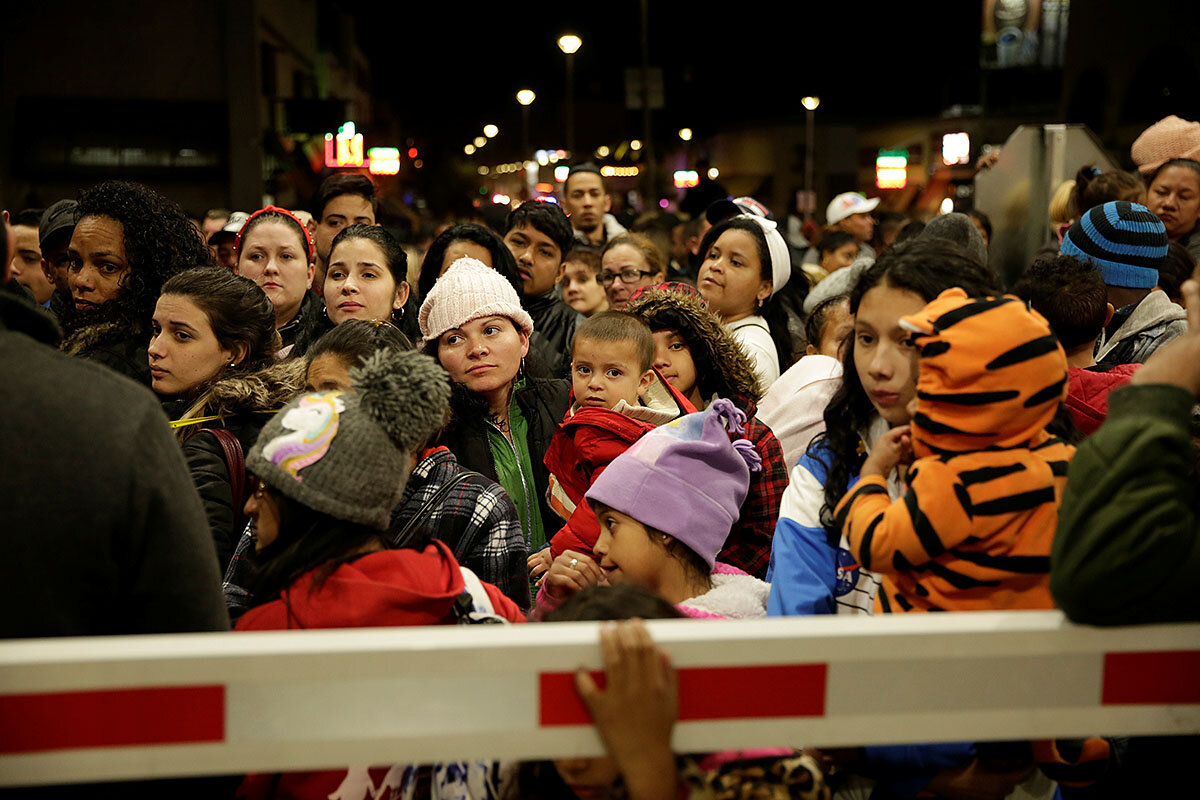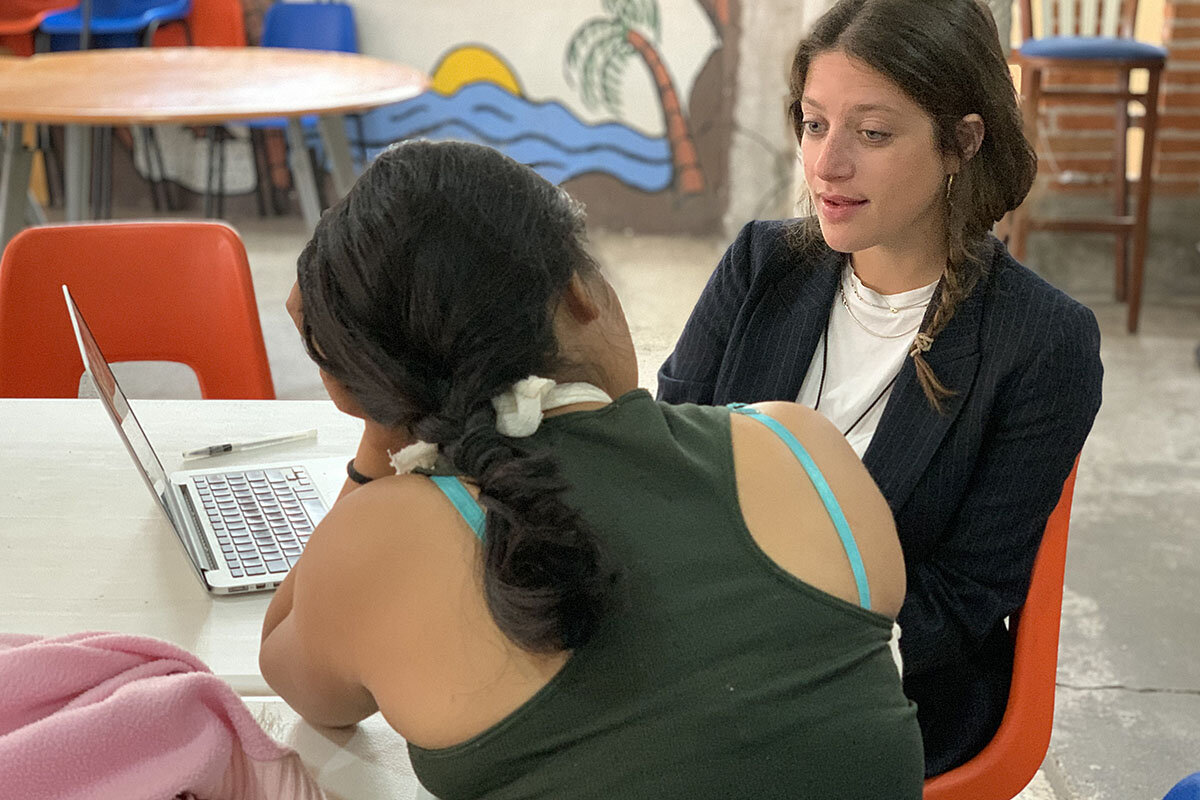Caught in the middle: How Mexico became Trump’s wall
Loading...
| Mexico City
It’s a tough crowd gathered around the white plastic tables in this sparsely decorated cafeteria on a recent morning. The eight boys and one girl awaiting a presentation are giving off universal signs of teenage ennui: hands splayed over faces, holding up their heads like they’re carrying the weight of the world, with zippers, baseball caps, and beanies perfect for fidgeting.
But these kids ‚Äì ranging in age from 11 to 17 ‚Äì aren‚Äôt your average tweens and teens.¬Ý
Each picked up and, alone or with young siblings, left their homes in Honduras and Guatemala the week before to join the latest migrant caravan headed toward the United States. One 16-year-old, Edwin, said goodbye to his 12- and 8-year-old siblings, whom he‚Äôd been caring for alone for years after one parent moved to the U.S. and the other remarried and started a new family. He was fleeing gang recruitment ‚Äì a clear pathway to a life of violence and early death¬Ý‚Äì¬Ýand poor prospects for education and work. The 12-year-old is now in charge back home.
Why We Wrote This
Curbing migration has been central to President Donald Trump’s vision for years. But he can’t do it alone – and Mexico has come to fill a surprising place in the new system. Part 2 of 3 on the changing landscape of immigration.
Part 1: Meet the immigration attorney trying to serve 2,000 asylum-seekers
Part 3: 2,000 miles, 72 hours, a tough choice: Asylum in Guatemala, or go home?
‚ÄúI‚Äôll be able to help them out more if I‚Äôm safe and working in the United States,‚Äù Edwin says. The minors in this story are identified with pseudonyms for their protection. ‚ÄúTwelve isn‚Äôt that little,‚Äù he says, a reflection of how early childhood ends in many parts of Central America.¬Ý¬Ý
The fact that today’s know-your-rights meeting is focused on minors is a telling detail about how profoundly asylum and migration to the U.S. have changed over the past several years. As the U.S. repeatedly tweaks the rules of seeking asylum at its southern border, a roomful of children trying to understand their rights – once an extraordinary scene – has become more common.
“With Trump, asylum isn’t working,” says Nikki Stoumen, an American volunteer leading this session explaining possible paths to legal status in the U.S. for unaccompanied minors. She worked for years in Louisiana on Special Immigrant Juvenile Status (SIJS) cases, one of the pathways she’s describing to these kids today.
“I can tell someone, ‘This is what is supposed to happen, what the U.S. says should happen,’ but things are up in the air right now,” she says. “We can’t be sure of anything.”
Overwhelmingly, the view from Mexico and Central America is that President Donald Trump’s long-promised border wall is a fait accompli – simply constructed further south. That transformation, critics say, has come with the assistance of Mexico’s new president, despite his campaign promises to defend migrants’ safety and rights as they pass through his country.
“Mexico is building the wall for the U.S., and it’s a very, very visible wall,” says Alejandra Delgadillo, who manages the Mexico programs for Asylum Access, an international nongovernmental organization, referring to deportations on Mexico’s southern border.
Mexican Ambassador to the U.S. Martha B√°rcena put it bluntly in a January interview with ∫£Ω«¥Û…Ò: ‚ÄúTo be totally frank ‚Äì and I‚Äôve said this [to] many congressmen ‚Äì U.S. immigration and asylum laws are not working, and what you‚Äôre doing ‚Ķ is outsourcing solutions for your broken system to other countries.‚Äù
However, she pushed back on the idea that Mexico serves as a de facto buffer zone for its northern neighbor. “I wouldn’t say Mexico’s policy is turning people back,” or serving as an invisible wall, she said. “Mexico is trying to let people know that you also have to respect certain rules, including migration law in Mexico.”
Cross-border cooperation
Since 2017, the United States has taken steps to clamp down on its southern border, arguing drastic measures were necessary to deal with staff and detention shortages for the growing numbers of asylum-seekers. Changes have included executive orders and regulations that separate families entering the U.S., deport Central Americans to Guatemala to seek asylum there first, and send asylum applicants back to Mexico to await U.S. court dates, though a federal appeals court blocked the yearlong practice in February. The U.S. government has also created new limits to asylum, ruling that domestic abuse and gang violence will no longer be considered relevant factors, and implemented “metering” to control the number of people allowed to ask for asylum at a border crossing each day.
Mexican President Andrés Manuel López Obrador, meanwhile, came into office a little over a year ago touting a new approach to migration, centered on human rights. He said there was work for Central Americans in Mexico, and that they wouldn’t be criminalized for crossing the border.
Then came April 2019. After nearly 110,000 people were apprehended at or near the U.S. southern border ‚Äì the largest monthly number in over a decade ‚Äì President Trump threatened Mexico with tariffs if it didn‚Äôt do more to halt migrants and refugees arriving on the U.S.‚Äôs doorstep. Soon after, Mexico deployed its newly formed National Guard to its own southern border.¬Ý
Deportations jumped almost immediately: More than 31,000 migrants were apprehended on the Mexico-Guatemala border in June 2019, the highest monthly total recorded since data became available in 2001. Abuse also soared, human rights experts say.
As the U.S. created more restrictions to asylum, Mexico continued to bear an outsize portion of the pressure. Between January and November 2019, Mexico’s refugee commission (COMAR) registered asylum applications, compared with roughly . Asylum requests for three consecutive years. Meanwhile, COMAR’s budget was slashed to the lowest funding in seven years, about $1.2 million.
And it‚Äôs not just asylum-seekers in Mexico, where people are in theory guaranteed access to health care, education, and work permits, who are straining Mexican resources. Via programs like the U.S. Migration Protection Protocols, the recently blocked initiative commonly referred to as ‚Äúremain in Mexico,‚Äù those seeking protection in the U.S. are waiting in some of Mexico‚Äôs most dangerous cities and states for months.¬Ý
“Migrants are suffering more,” says the Rev. Luis Eduardo, who runs the migrant shelter Casa Nicolas, about 2.5 hours from the U.S. border in the state of Nuevo León. He’s seen fewer people arriving over the past year, which he believes is due to Mexico’s crackdown. But most are staying longer, as they try to create a plan that balances safety with the ever-changing realities on the U.S. border.
“The U.S. doesn’t want them, which the government’s policies have made clear. Mexico is detaining and returning them forcibly and complementing U.S. policy. Where does that leave us?”
High-stakes choices
Like many migrants hoping to make it to the U.S., 16-year-old Diana starts by describing her story in generalities: Honduras is dangerous. Criminals are so ruthless there, she says earnestly, even dogs and cats are under threat.
Ms. Stoumen nods and inhales deeply. She and a lawyer from the Mexico City-based NGO Institute for Women in Migration, which helped organize today’s visit, have offered to speak with the teens one-on-one about their situation after the information session wraps, though they can’t offer specific legal advice. “I know crime is horrible,” she says. “But asylum isn’t for generalized violence.”
Diana, with one arm in a sling and shoulders covered by a bubble-gum pink sweatshirt, goes a little deeper. Her 7-year-old brother was throwing rocks and accidentally broke a gang member’s window. He came for her brother at school, intimidating him. Then he came to the family’s home and threatened them, killing their dog and cat.
“I want to be something in life. If I can get support here and can study, I’ll stay,” she says, weighing her desire to study computer science in the U.S. with the risks of continuing her journey beyond Mexico.
Of the kids Ms. Stoumen has met today, she thinks one might have a chance at SIJS, which is reserved for minors who have been abandoned, abused, or neglected by their family and have relatives who can care for them in the U.S. Despite challenging home lives and dangerous communities, few of them would make it far in the U.S. asylum process, she suspects.¬Ý
The makeup of migrants passing through Mexico has changed dramatically in recent years, says Er√©ndira Barco, the social worker at the Scalabrini Mission with Migrants and Refugees Casa Mambr√© shelter where the information session is taking place. Whereas in the past there were primarily single men motivated by economic opportunities, the main reason migrants staying in the shelter tell them they‚Äôve left home is now violence, she says. The number of unaccompanied minors and family units has also shot up.¬Ý
“The reality of the situation on the U.S. border is starting to sink in,” Ms. Barco says, of migrants staying at the shelter deciding if Mexico will be a part of their journey or the end point. “But many continue to fight” to make it to the U.S.
She expects most of the kids at today‚Äôs information session will return home, though. They‚Äôre young, they‚Äôve been through a lot, and they‚Äôre starting to realize how hard it is to calculate their futures.¬Ý
‚ÄúI just want to be safe,‚Äù says 16-year-old Jorge, who describes unwanted recruitment from two opposing gangs pushing him to flee Honduras. ‚ÄúI can‚Äôt go home. My country is ‚Ķ‚Äù He trails off for a moment, looking out the cafeteria window to a bustling Mexico City street.¬Ý
“If I go back home, I’ll die.”






